Fight The Dragon is a good, old-fashioned 3D hack and slash game with some light platformer and RPG elements, so those who enjoy games like MediEvil should seriously consider giving this game a try. There is full online multiplayer support here and enemies scale automatically with your level through basic stat boosts and more frequent random modifiers. Both the combat and the platforming elements are undeniably wonky, but enjoyably so, giving this game that unique sense of rough, slightly chaotic PS1-era charm. However, the biggest drawing point for Fight The Dragon is bound to be the fact that this is another game which thrives on content made by the community with a massive level count of over 10,000 and growing.
I normally divide articles on games focused on player-created content between discussing the editor and the actual game, but in this case I am just not personally familiar enough at this time with Fight The Dragon‘s editor to take a serious look at it, so we’ll be jumping straight into the gameplay. There are four classes to choose from, Fighter, Black Rogue, Fire Lord, and Ice Wizard. Every class has access to melee and ranged weapons, but several types of weaponry are exclusive to a specific class or to two out of the four; Fighter and Black Rogue have access to more powerful physical weaponry while Fire Lord and Ice Wizard can use more magical items. Other than some equipment restrictions, each class has its own set of eight special abilities, one of which unlocks every fifth level, but only four out of the eight can be taken into an adventure. Many of these abilities are extremely useful, such as the Black Rogue’s stunning lightning trap and the Fighter’s deadly whirlwind spin, but they also consume enough energy to use that they can’t be spammed endlessly, so equipment tends to play a larger role in defining a character than skills. The final way in which characters are defined is in terms of stats, though this has nothing to do with the classes themselves. There are four stats in the game, strength, endurance, luck, and defense, and, other than occasionally learning a new skill, the only reward for gaining a level is a single stat point which the player can choose to distribute as they please.
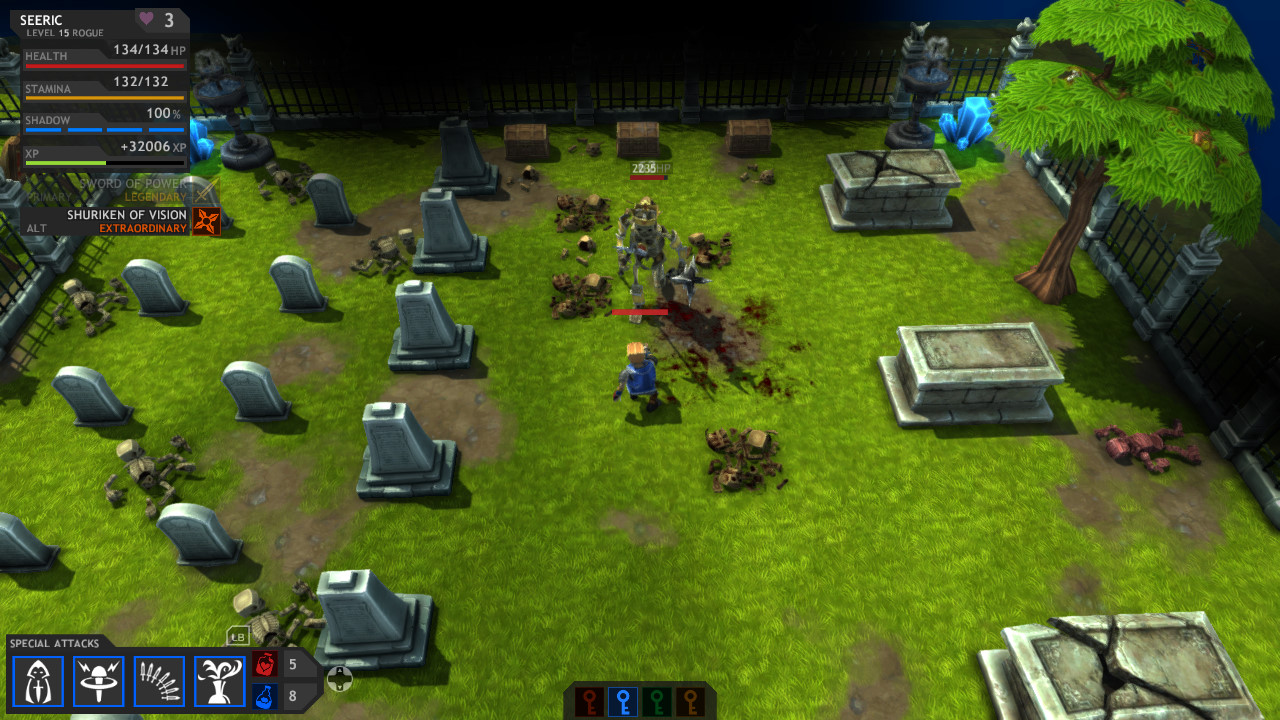
Combat is fairly standard for this particular type of hack and slash game, though there is some more complexity beyond mindless button mashing. Every weapon has its own normal attack combo and a stronger heavy attack, the latter of which costs some stamina to use, though stamina automatically recharges at a steady pace. There are quite a few different weapon types in the game, players can equip two different weapons at a time to quickly swap between, and weapons shared between two or more classes may have different attack combos and/or heavy attacks depending on the class using it, so there is no shortage of variety when it comes to weaponry, though generally melee weapons are better for taking care of groups of smaller enemies while ranged weapons are better for picking off stronger single targets. Players also have an invaluable dodge roll at their disposal which grants invincibility frames and, if they aren’t using a two-handed weapon, they can make use of a shield to mitigate incoming damage or Ice Wizards and Fire Lords and substitute a magical tome for a shield, which charges as damage is taken and unleashes a devastating spell once fully charged.
Make no mistake, even with the shield and the dodge roll the combat system is still largely about fast-paced chaos. Fighting groups of enemies mostly consists of hacking away as quickly as possible while chugging healing potions or making use of skills and heavy attacks to quickly annihilate the group. Finesse comes into play when confronting the many larger miniboss enemies of the game, such as golems, elementals, evil spellcasters, and knights. Getting hit by these foes does significantly more damage than usual and even a full pack of ten health potions won’t last for long against them if you pay no heed to defense. Thankfully, the stronger enemies clearly telegraph their attacks, allowing for plenty of time to dodge out of the way, though fighting multiple minibosses simultaneously or alongside a massive group of enemies still results in fights which are delightfully messy and chaotic.
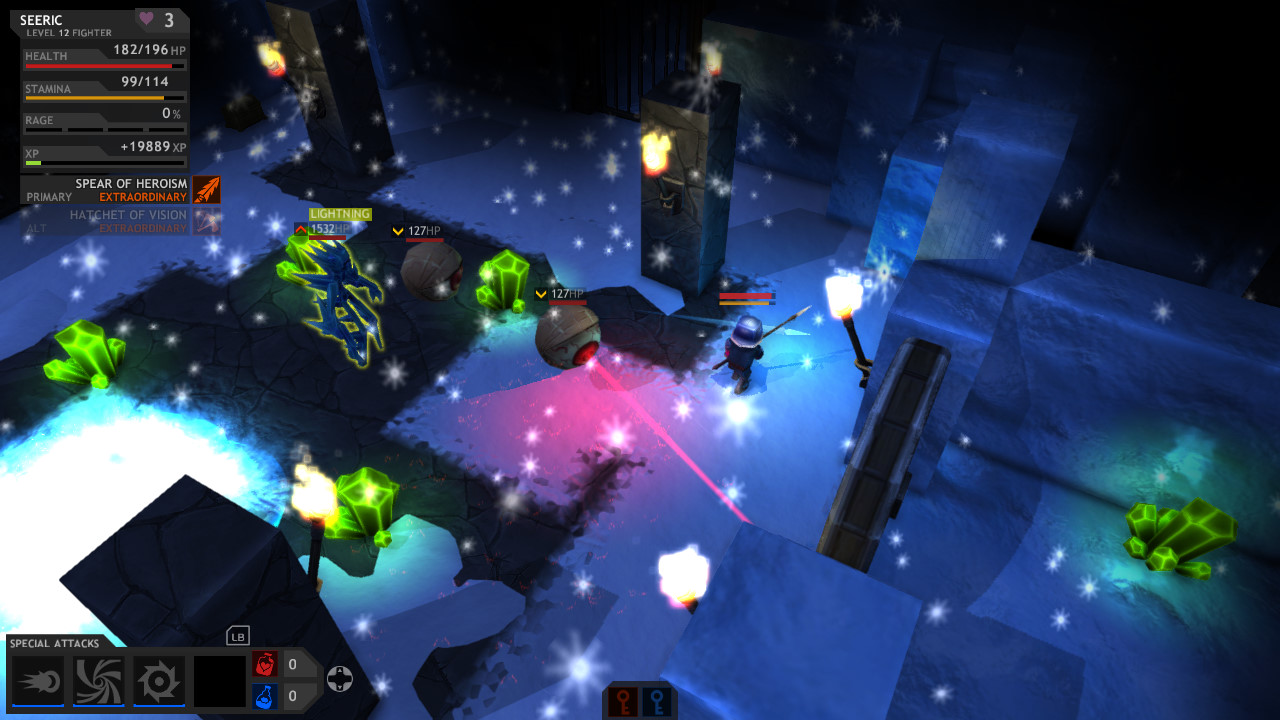
The one downside to the combat system is that ranged weapons can easily break it. Even though ranged weapons tend to be much slower than melee weapons, few enemies are equipped to deal with distanced attacks, especially if the weapon can stun or slightly knock back opponents. Large groups and spellcasters still pose a threat when using ranged weapons, but smaller groups can be picked off one at a time before they reach the player and melee-oriented minibosses can be stunlocked or knocked back enough that little to no movement is needed on the player’s part even if the enemy has thousands of health and takes dozens of hits to kill. The AI also sometimes just doesn’t know how to deal with a player attacking from as far away as possible and monsters will sometimes soak up several hits before they start to fight back, assuming they don’t just drop dead within the first few hits. Ranged weapons are fun to use, but their tendency to trivialize encounters means that players looking for a challenge will need to learn to use them sparingly.
Like the combat, platforming is slightly messy in a way which is usually more amusing than frustrating. Other than running, which consumes stamina, most platforming elements occur automatically. Pressing forward while facing a low enough ledge will cause the player’s character to climb up onto it and jumping is context-sensitive. Jumping only occurs while crossing a gap, but players will need to get into the habit of holding down the run button beforehand as failing to do so will usually result in dropping down to the floor below (or into an instant-death pit). The act of jumping definitely takes some getting used to and it can sometimes be hard to judge if a gap is small enough to leap across, especially if there is a height different between the platforms in question. Still, jumping is only really an issue if platforms are diagonally across from each other or at strange angles as jumping between platforms which are in a straight line is a much more reliable and smooth experience.
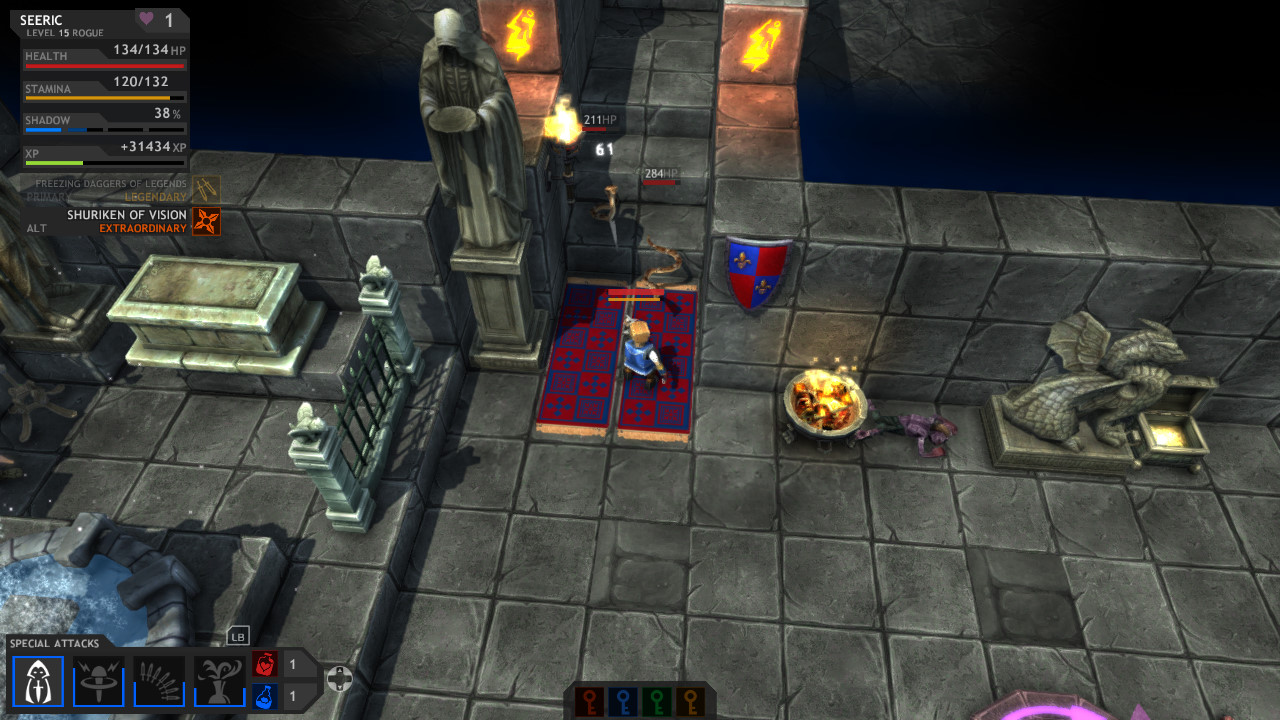
The player-created content is far and away the main source of appeal for Fight The Dragon and it is handled exceptionally well. Once players leave their small floating island home, which serves as the hub, they are presented with a large grid and a list of adventures which can be slotted into the squares making up the grid to form a map of sorts. There are no restrictions on which adventures can be chosen and since loot, random enemy modifiers, and enemy levels all scale alongside the player any adventure is viable to try or reply at any level, though some are definitely designed with higher-end gear and skills in mind. In addition to the automatic scaling, what makes this particular presentation work so well is just how extensive the sorting capabilities are. The basic outline of each level is displayed in advance, which can be used to get a rough idea of how long or complicated it is, and underneath this outline is a clear listing of how many positive, negative, and neutral ratings the level has received by players. Levels can be sorted by date added, by popularity (or lack thereof), by the number of positive ratings, by creator-defined difficulty, by author, and in several other ways as well. For those looking for a more specific type of level, there are dozens of tags built into the game which can be toggled on or off and players can manually enter their own custom tags to search for. Alternately, players can choose to be given a level completely at random and every eight hours new levels are chosen as ‘reward’ levels which grant extra loot and experience.
Fight The Dragon refers to its levels as ‘adventures’ and this label seems appropriate as there is usually more to a level than combat. Pressure plates and levers are commonplace and can make for interesting puzzles or for more open, exploration-heavy levels and cracked walls often hide paths or treasure. Colored keys can be found to unlock doors and a large number of different NPC’s can be found which may trigger events or simply provide some flavor text. Checkpoints are one of the most important elements involved in shaping a level’s difficulty as each checkpoint touched grants an extra life to every player in the stage (this includes reviving players who have run out of lives) and standing on a checkpoint grants a finite amount of healing. Creators are free to place as many treasure chests in their levels as they desire, but there is always a large chest somewhere in every level and the ultimate goal is always to reach an obelisk at the end, but how much actual loot is in the chests beyond potions and trivial amounts of gold is determined by how many enemies and which types of enemies are present in the stage and have been killed by the player, so it’s a bit harder than usual (though unfortunately not entirely impossible) for maps to be created purely for the purpose of farming loot.
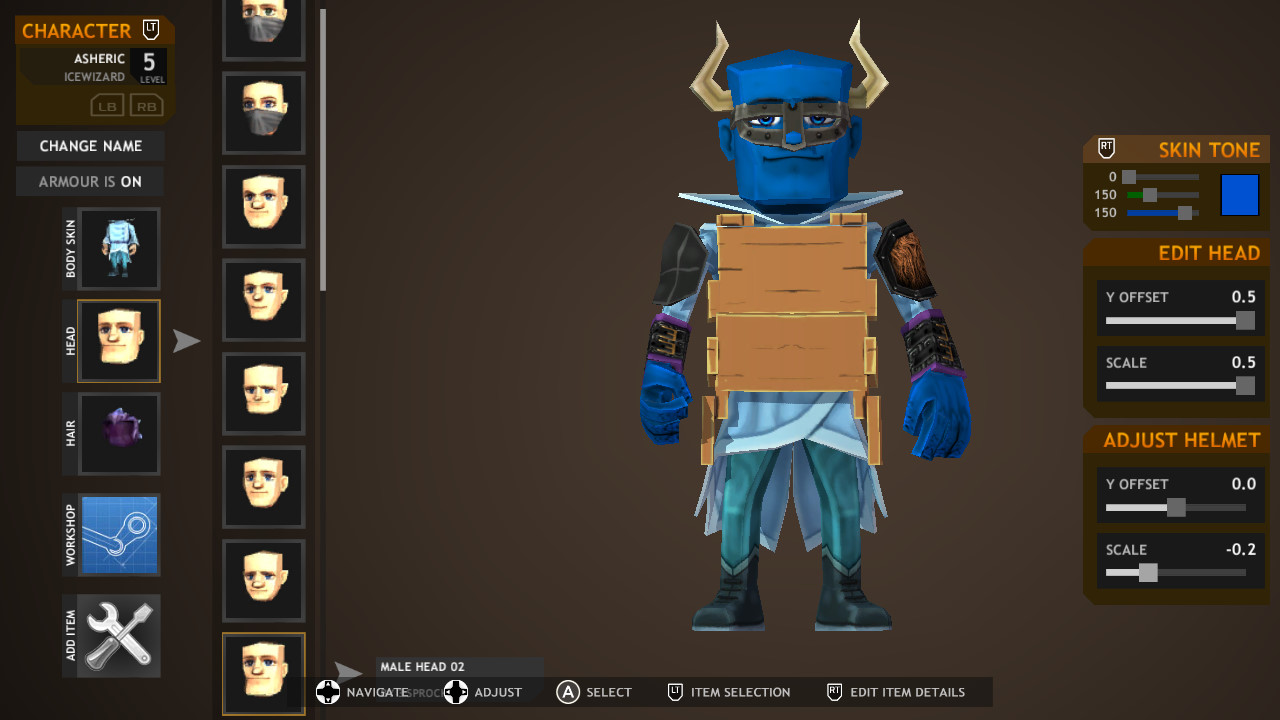
The world has an overall ‘blocky’ look to it, no doubt due to the environments being made up of blocks in the editor to make creating levels easier, but these are certainly not Minecraft graphics as only walls and floors have this look while trees, furniture, barrels, and other environmental objects have normal shapes. There is also no shortage of variety to the types of environments as large forests, mansions, crypts, lava caves, deserts, towns, and more than a few other types of internal and external regions are all common and levels frequently mix and match them. Some of the best levels in the game do a fantastic job of hiding all sorts of secrets throughout the environment while less carefully crafted stages can sometimes be broken in half if players can find a way to climb up on top of a wall to skip large chunks of the level, but finding unintended ways to traverse a level can be just as much fun as playing through a level in a more legitimate manner. Likewise, the vast majority of levels are designed as solo experiences and both the combat and the puzzles can be broken by a group of two or more players, but the complete chaos created by the multiplayer aspect is fantastic and silly; finding a random group to join for multiplayer can be difficult, but playing Fight The Dragon with a group of friends is an experience which doesn’t get old even after playing for hours on end so I would strongly recommend playing this game with at least one other person if you can. Lastly, one of my favorite features in Fight The Dragon is the ability for creators to make ‘campaigns’, which are listed separately from individual levels and consist of two or more levels which players must complete in a set order to create a small game within the game, a feature which I wish was far more common in games with player-created content.
Considering how large of a role equipment plays in defining a character, it’s probably not surprising that the loot system is a large part of the game. Equipment is divided into five different tiers with more, and often better, modifiers on items at higher tiers. One or more stat bonuses can be found on many pieces of gear, which between weapons, shields, helmets, shoulder pads, body armor, gloves, and boots can easily add up to more than doubling your power. There are dozens of other modifiers which do any number of things, such as providing a stun chance, reducing damage from poison, reducing stamina costs, increasing damage from specific types of weapons, and many other things, all of which can be stacked together to make for some absurdly lethal combat capabilities. Characters do have limited inventory space, but running out of room is rarely an issue unless you decide to go through multiple levels in a row or pick up every single piece of loot no matter how bad. There are also some nice quality of life features in the form of the ability to lock an item, preventing it from accidentally being dropped, and a shared storage which is great for if you find a piece of gear on one character which would be better for or only usable by an alternate character. Furthermore, even trivial loot isn’t worthless as unwanted items can be cashed in at the Loot Shrine in the main hub. Each item has a specific value assigned to it which, along with any gold found, fills up a meter in the Loot Shrine which can be cashed in for prizes at four different tiers. When you decide to cash in your accumulated points at the Loot Shrine you are presented with a choice between three different random rewards from the current tier’s list, which can include gear, but which also includes essential, permanent upgrades, such as more inventory space, more stamina or health, or even a stat point at the highest tier. The presence of this Loot Shrine really is a game changer for the genre as it’s a brilliant way to make finding any piece of loot feel exciting and rewarding regardless of its value as usable equipment.
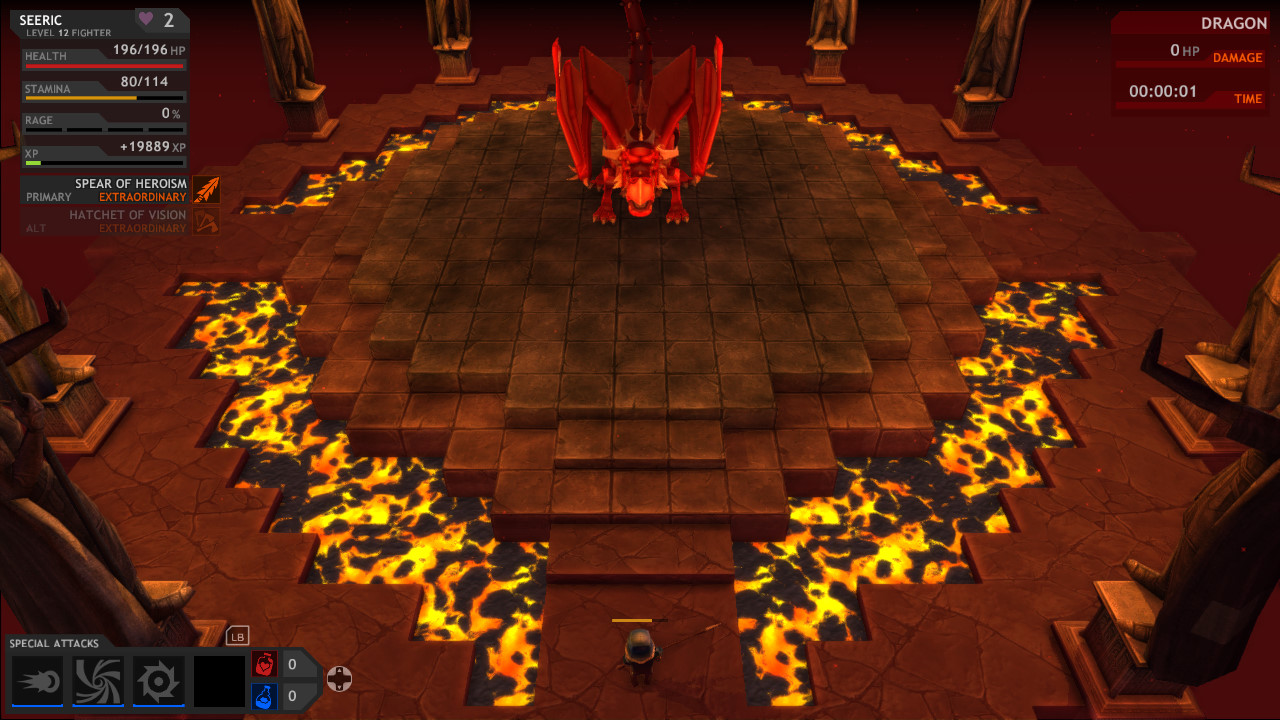
As odd as it may sound, the one part of Fight The Dragon where the game falls flat is in the matter of actually fighting the dragon. Completing adventures grants dragon scrolls which can be used to enter the arena where the dragon in question is fought. This dragon has a whopping 1,000,000 health and has plenty of deadly attacks to make it a difficult fight no matter how a player chooses to approach it. The catch here is that the dragon’s health doesn’t refill between attempts and damage dealt even carries over between characters. Unfortunately, there just isn’t much to this part of the game. Yes, the dragon’s attacks are dangerous, but players will see all the fight has to offer after even a single attempt. The dragon can also only be fought alone and consists solely of the dragon on a raised arena platform so there isn’t any sense of adventure to it. Hitting certain damage milestones rewards players with dragon rings, the only items in the game which can go into the ring slot, but these rings are rather odd. Rings often have powerful benefits, but they also come with penalties (ex: increased healing potion effectiveness at the cost of weaker energy potions), they can’t be worn while fighting the dragon, and they have time limits, after which they can no longer be used; I usually just donate the rings to the loot shrine since unworn rings grant thousands of points. Thankfully, fighting the dragon isn’t remotely mandatory and is an activity which can be safely ignored with no loss beyond the rings, but I am baffled by how completely disconnected this fight feels from the entire rest of the game.
Fight The Dragon is outright one of the best games the hack and slash genre has to offer. The sheer amount of content created by the community is astounding, the search tools built into the game make it easy to find any type of level you may be looking for (and of any quality you may be looking for), multiplayer is a blast, and the balance between chaos and care in the combat system complements the focus on player-created levels by making for a game which is fun regardless of if you’re traveling through an expertly crafted adventure or a chaotic mess.